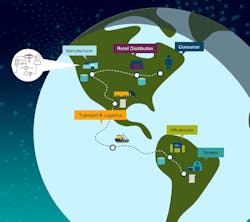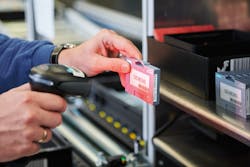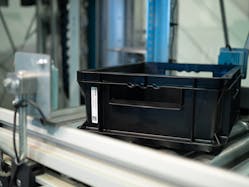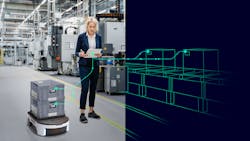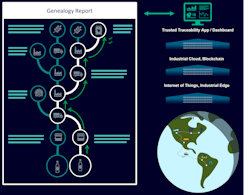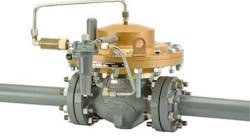A recall is undoubtedly one of the worst things that can hit a processor in the food and beverage industry because it creates an internal frenzy to control damage, undermines company reputation and slashes profits as mitigation ensues. Traceability systems are central to recall situations for two main reasons:
- They house the data used to hunt down impacted products and ingredients, with an outcome that varies based on the quality of recordkeeping and how user-friendly the system is to navigate.
- Better traceability systems, especially automated real-time identification and locating solutions, can identify issues as they arise, often eliminating recalls down the road.
Historically, tracking within a facility was performed manually with pen and paper records, but industrywide digital transformation initiatives and success stories are pushing processors toward automated solutions.
Modern enhancements for internal traceability include radio frequency identification (RFID) and barcode systems, vision inspection and labeling systems, and software for managing associated records. These tools bolster internal operations, and also make it possible to provide suppliers, distributors and regulators with one-step-forward and one-step-backward traceability when required.
The need for digital alternatives
Traceability is more complex than merely installing central software, such as an enterprise resource planning (ERP) or manufacturing execution system (MES), to track and maintain records. Hardware must also be strategically selected and configured to work together with software. For many food and beverage processors, it is difficult to forecast implementation results, creating a barrier to beginning a project.
However, the financial and reputational risks of compromised products and possible recalls are too great to continue using pen-and-paper tracking methods. Digital solutions automate a great deal of formerly manual procedures, reducing the propensity for error that can lead to these types of catastrophic situations.
As food and beverage processors begin planning the transition to digital track-and-trace solutions, they must strategically determine what to track in these systems. Agreements require buy-in of suppliers, processors and distributors because these systems work best when all stakeholders can openly share data from their respective operations (Figure 1).
Implementing proper cybersecurity practices is of paramount importance because food and beverage processors transmit and consume data from outside their facilities. For example, cloud data systems enable the tracking of ingredients from a farmer’s field into a food processing facility, and all the way to the grocery store where products are sold for consumption, but this requires enabling data access to all parts of the supply chain. Processors must maintain cyber safeguards as they implement these types of solutions.
Selecting the right tracking technology
Manufacturers in the food and beverage industry looking for flexible production control, efficient asset management, reliable operation and component tracking, and/or intelligent supply chain synchronization can benefit from industrial identification and locating solutions. Depending on the application, three primary technologies can be used within a facility:
- RFID, which reads and writes information from and to tags for tracing as they move through production lines.
- Real-time locating systems (RTLS), which use radio communication within a facility to assign x-y geocoordinates to the location of goods.
- Optical code-reading systems, capable of recognizing 1D codes, like barcodes or 2D codes, such as data matrix codes (Figure 2).
When knowing the location of products and components is the chief concern, users should implement identification and locating solutions. These types of installations help address the question, “What ingredients are where and when?” by quickly and reliably providing answers. This is done with machine-readable, automated and contactless identification systems that synchronize virtual data streams in IT systems with the actual flow of goods. Synchronization services help ensure maximum transparency — not only in production processes, but also in logistics and warehousing.
Both radio and optical solutions are highly reliable for this purpose, and the best choice depends on the application. Both of these technologies help processors attain gap-free traceability of products and components throughout all phases of manufacturing and purchasing, and dispatching workflows.
Verify the right ingredients with RFID tags
Many manufacturing processes require mixing or blending various components, and once mixed, the end products are packaged for distribution. Oftentimes, the ingredients used in different recipes look similar, and finished products may even appear analogous but have very different properties.
To verify use of the correct ingredients in specific products, manufacturers must place proper verification systems in service. For digital enterprises trying to eliminate paper travelers, pens and clipboards, this is best accomplished with the use of RFID tags or RTLS transponders attached to the material handling containers that hold each ingredient, enabling unique identification and location of their contents.
An RFID tag can be thought of as an electronic license plate for each container, with ingredient information stored on the tag. At the station where each container is filled, an RFID scanner records the contents to the container’s tag for identification and tracking down the line. When the container is moved to the next operation, the tag is read to identify the contents (Figure 3), and if confirmed to be the ingredients expected by recipe control system, its contents are added. In the event the contents do not match expectation, the process is placed on hold until the issue is resolved.
RTLS also provides the ability to monitor ingredient temperature — based on location within a refrigerator, for example — and other time-sensitive properties in real time, using radio transponders to transmit data to a central hub.
Geolocate goods with RTLS
Many facilities require meticulous temperature tracking to confirm ingredient and end-product suitability. Traditionally, this was done using pen and paper, creating records each time a crate with goods subject to spoilage was moved. However, this task can now be executed automatically with RTLS.
By placing series of antennas, called “gateways,” at critical points in the facility — such as at the entry/exit point of cold storage — the movement of goods can be automatically tracked. This methodology, known as geofencing, creates events when electronic radio transponders placed on crates enter certain zones (Figure 4). By stringing together the events, processors can verify the amount of time each good spent in every location, e.g., how long was a good outside of refrigeration.
All of this data is stored in a central location where it can be accessed by multiple supervisory or control systems to make use of it, including MES, ERP, just-in-time recipe management, laboratory information management and other systems for operational optimization. Data can be stored either on-premises or in the cloud, depending on user preferences and policies.
By aggregating and analyzing all this data before finished products are distributed, processors can ensure everything that leaves a facility meets all regulatory requirements, substantially reducing the risk of recalls.
Trusted traceability using blockchain technology
During a routine quality check, a large brewer and packager noticed imperfections in a number of bottles queued for distribution, each of which could cause minute pieces of glass to be deposited in the product. After learning about the issue, a swift recall was implemented, causing consumer concern and manufacturing delays as analysts performed root cause analysis.
Addressing problems in the process, the brewer implemented Siemens’ Blockchain-based Trusted Traceability Solution to mitigate these and other types of issues, and to expedite future recall scenarios throughout the brewer’s extensive supply chain (Figure 5).
The team began implementation by leveraging the cloud-based IoT platform, MindSphere, to display timeseries data in an intuitive interface. The primary objectives for the new solution were to:
- Reduce time to identify glass bottle defect sources.
- Refine data accuracy to optimize safety margin in recalls.
- Lay a foundation for upstream and downstream supply chain transparency initiatives.
The brewer’s previous traceability procedures were primarily manual with a considerable risk of human error, data housed and handled in spreadsheets, and communication discovery conducted via phone or email. It took an average of 8-12 hours for a stock-keeping unit to track the location of impacted product using the old methods, but with automated correlation of inputs and outputs in the new Blockchain-based Trusted Traceability Solution, product location feedback is nearly instantaneous (Figure 6).
The implementation was so effective in its facility that the brewer is looking to expand and integrate this technology throughout its supplier and distributor networks as well. Upon project completion, the brewer experienced measurable improvements, including:
- Time reduction: tracking impacted products, which required 8 to 12 hours before, now only takes minutes.
- Resource reduction: previously, an impacted product search required effort from five different operating teams, but it can now be completed by a single person.
- Recall reduction: the average direct cost of a recall is $9.5M, and the impact on sales and reputation is an estimated $50-60M per occurrence.
- Highly reliable data accuracy: the recall product safety margin decreased by 25%, providing more precise targeting of impacted product in the event of an issue.
Automate to reduce recall risk
Identification and locating systems help track goods throughout the entire supply chain from raw materials, through production and up to the point finished goods reach end customers. They help eliminate manual and time-consuming processes by replacing them with fully automatic identification of tagged components moving through a facility. These systems also detect and significantly reduce incorrect deliveries, helping eliminate bottlenecks and machine downtime, while optimizing inventory.
Implementing these sorts of solutions is not without its challenges, and processors must be strategic about what they trace and how they share associated information. Therefore, the counsel of solution providers should be sought because they can help pinpoint the best technology for each application, and then guide rollout in a cybersecure manner.
These automated tools help processors minimize spoilage, identify compromised goods and ensure product safety and regulatory compliance. As data is generated, managed and communicated, processors can rest assured that all product leaving the facility is in compliance, and tracked up to the point of purchase if required.
Jeff Snyder is the industrial identification and RTLS product manager at Siemens, where he provides sales and product support for RFID and RTLS products. He has over 30 years of experience with industrial identification and factory automation systems. Beginning his career as a machine vision applications engineer, Jeff moved into applications engineering management in addition to business development and product management. He holds a BS degree in electrical engineering from the University of Cincinnati.

